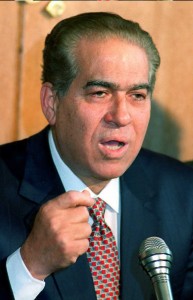
By Islam Zayed
The caretaker government, led by Dr. Kamal El-Ganzouri, has written a pilot plan for the next administration to move beyond the current transitional phase toward recovery from the current recession.
The plan aims to achieve social justice, to raise the living standards of Egyptian citizens, and to develop a strategic, 20-year vision to transform Egypt’s social and economic reality.
The plan, according to a copy obtained by Daily News Egypt, states that Egypt will pass through three stages beginning with the new fiscal year.
The first period, dubbed the “social recovery stage,” is expected to take two years from 2012 to 2014, and is aimed at achieving political stability and social justice. The stage is considered the beginning period of economic recovery where growth rates are hoped to be between 3 to 5%.
The second phase, which will last five years, will aim at higher growth rates. The private sector should be the driving force of the economy, as it should absorb domestic investment and entail the expansion of the agricultural sector as well as industrial growth.
The third phase of accelerated growth will follow and last until the year 2022. The third stage aims to achieve social stability and to raise the standard of living as well as to grow the agricultural, industrial, tourism, and service sectors.
According to the plan, next year’s target is for the Egyptian economy to overcome the period of instability and economic downturn caused by the revolution and to concentrate policy on achieving quick growth. The plan seeks to ensure that growth is felt by all segments of society, especially the less fortunate, and to combat the issues of unemployment, poverty, and the low standard of living of many Egyptians. The plan aims to create new jobs through labour-intensive projects, to restructure the industrial sector, and to exploit Egypt’s strategic geographical location by attracting outside investors. The plan outlines solutions for all the problems of the transitional period. Economically, the plan calls for the government to implement a phased plan to restore growth rates by stimulating economic activity.
According to the plan, the government will seek to increase investment, to exploit idle production capacity, and to help develop small and micro enterprises. The government will also develop the education, and health care systems with investments of more than EGP 16.9bn, an increase of EGP 3bn from last year. The government aims to rely more on private sector investments, which are hoped to make up between 54% and 61% of total investments. Private investment is hoped to support public companies with up to EGP 34.5bn.
In terms of reducing the budget deficit and controlling the rate of increase of public debt, the plan includes a package of measures to re-formulate public spending, including changes to government employee compensation and government procurement procedures.
The plan also included a phased program to rationalise oil subsidies to reduce unnecessary consumption, taking into account the re-pricing of natural for energy-intensive industries. It will seek to re-price exported gas, a step expected to increase government income between EGP 4bn and EGP 6bn annually.
For the problem of unemployment, the plan emphasised that increased growth rates will go a long way reduce the number of unemployed workers whose numbers rose from to 3.2 million since 2011. With a great deal of optimism, the plan stressed that the government will be able to absorb of new entrants to the labour market to reduce the number of unemployed, a problem exacerbated by the return of former Egyptian expatriates from other Arab countries during the Revolution.
During the coming year, the plan seeks to reduce the unemployment from the current rate of 12.4% to 9.9%, a total of 2.7 million unemployed workers. The plan proposed a set of policies to create new jobs, including re-opening factories, supporting the development of small enterprises, encouraging labour-intensive economic activities, and providing loans for women in small enterprises.
It also addresses the issue of poverty, exhibited by an increasing gap between rich and poor in both rural and urban areas. The plan proposed to target the poorest villages with EGP 4.27bn in aid to cover the cost of projects in housing, sanitation, health, education, environment protection, youth empowerment. Only EGP 702m was allocated for such programs during the current fiscal year.
In the agriculture sector, the plan seeks to reclaim land and to develop farming techniques through investments of EGP 12.4b, an increase of 80% from last year. The government also aims to narrow the gap between agricultural exports and imports by increasing exports and enhancing Egyptian competitiveness in foreign markets.
The plan included a focus on providing subsidies for oil producing crops such as soybeans and canola. There are also provisions for cotton subsidies
It also called for increased financial allocations for agricultural research centers with a focus on programs to improve soil and to create more arable land. The plan calls for 2 million acres of the North Coast to be reclaimed for agriculture. It also called for self-sufficiency in livestock, poultry, and fish production through the establishment of independent body directly accountable to the President. The plan also called for stricter penalties for building on agricultural land.
Industry, however, is considered the country’s most promising sector for growth, as the manufacturing sector contributes approximately 15% to average yearly growth rates, the highest rate of contribution of any sector. The plan estimates that investments in manufacturing next year to exceed EGP 27.3bn, a 10% increase from last year. The plan proposed several national projects, including EGP 2bn in public funds for infrastructure projects in Port Said and Suez Gulf. The plan also outlined other infrastructure projects for the Sinai Peninsula and the southern Nile valley.
In addition, the plan included a plan to establish a project for the use of peaceful nuclear energy in electricity production.
In the oil sector, the plan outlined targeted investments between EGP 49.3bn and EGP 50.1bn, including investments in refining capacity.


